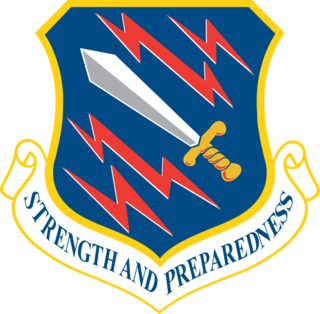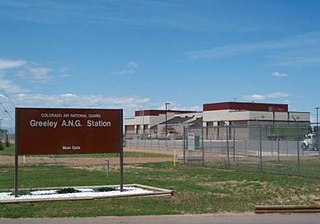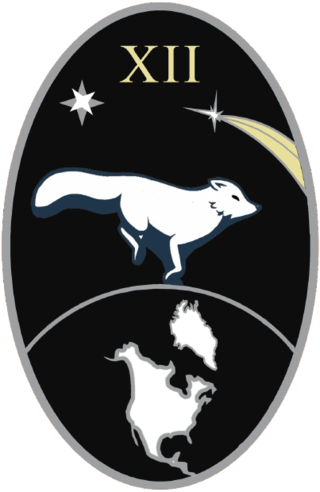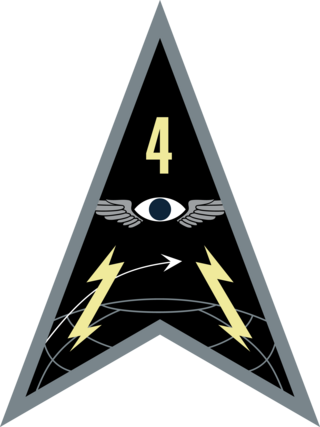United States special operations forces (SOF) are the active and reserve component forces of the United States Army, Marine Corps, Navy and Air Force within the US military, as designated by the Secretary of Defense and specifically organized, trained, and equipped to conduct and support special operations. All active and reserve special operations forces are assigned to the United States Special Operations Command (USSOCOM).

The Colorado Air National Guard (CO ANG) is the aerial militia of the State of Colorado, United States of America. It is, along with the Colorado Army National Guard, an element of the Colorado National Guard. The units of the Colorado Air National Guard are not in the normal United States Air Force chain of command. They are under the jurisdiction of the Governor of Colorado through the office of the Colorado Adjutant General unless they are federalized by order of the President of the United States. The Colorado Air National Guard is headquartered in Centennial, and its commander is currently Major General H. Michael Edwards.

The 21st Wing is an inactive wing of the United States Air Force.

The 168th Wing is a unit of the Alaska Air National Guard, stationed at Eielson Air Force Base, Fairbanks, Alaska. Before it was redesignated in February 2016, it was known as the 168th Air Refueling Wing. If activated to federal service as a USAF unit, the 168 WG is primarily gained by Pacific Air Forces, while its 213th Space Warning Squadron is gained by Air Force Space Command.

The 544th Intelligence, Surveillance and Reconnaissance Group is a United States Air Force unit assigned to the Air Combat Command Sixteenth Air Force. It is stationed at Buckley Space Force Base, Colorado. It was reactivated under the 70th Intelligence, Surveillance, and Reconnaissance Wing on 26 September, 2022.

The 310th Space Wing is an Air Reserve Component (ARC) of the United States Air Force. It is assigned to the Tenth Air Force, Air Force Reserve Command, stationed at Schriever Space Force Base, Colorado. The wing is the only space wing in the Air Force Reserve. It provides specialized expertise, continuity and combat ready personnel. It is mission partnered with several United States Space Force deltas: Space Delta 2, Space Delta 3, Space Delta 4, and Space Launch Delta 30.

The 460th Wing is an inactive wing of the United States Air Force. The 460th Space Wing was activated on 1 October 2001, replacing the 821st Space Group. It was inactivated on 24 July 2020 and replaced by the Buckley Garrison.

The 140th Wing is a unit of the Colorado Air National Guard, stationed at Buckley Space Force Base, Aurora, Colorado. If activated to federal service, the Wing is gained by the United States Air Force Air Combat Command.

The 200th Airlift Squadron is an inactive unit of the Colorado Air National Guard 140th Wing located at Peterson Air Force Base, Colorado Springs, Colorado. The 200th was last equipped with the C-21A Learjet.

The 2nd Space Warning Squadron is part of the Space Delta 4 at Buckley Space Force Base, Colorado. It operates the Space-Based Infrared System satellites conducting global monitoring for significant infrared events.

The 233d Space Group (233SG) is a unit of the Colorado Air National Guard located at Greeley Air National Guard Station, Greeley, CO. The 233d Space Group provides immediate, worldwide missile warning as well as space launch and detection in the event of an attack against the United States. If activated to federal service, the Wing is gained by the United States Air Force or United States Space Force depending on decisions made in the hopefully near future by military leaders and Congress.

The 11th Space Warning Squadron is a United States Space Force missile warning squadron, located at Buckley Space Force Base, Colorado.

The 12th Space Warning Squadron is a United States Space Force ground-based radar used for missile warning, missile defense, and space situation awareness, stationed at Pituffik Space Base, Greenland.

The United States Air Force's 8th Space Warning Squadron is an Air Force Reserve missile warning unit located at Buckley Space Force Base, Colorado. The 8th works alongside its active duty counterpart, the 2d Space Warning Squadron, on the Defense Support Program and Space-Based Infrared System programs.

The 140th Operations Group is a unit of the Colorado Air National Guard, stationed at Buckley Space Force Base, Aurora, Colorado. If activated to federal service, the group is gained by Air Combat Command of the United States Air Force.

Space Operations Command (SpOC) is the United States Space Force's space operations, cyber operations, and intelligence field command. Headquartered at Peterson Space Force Base, Colorado, it consists of its mission deltas, and garrison commands.

Space Delta 2 is the United States Space Force's space domain awareness and space battle management delta and is headquartered at Peterson Space Force Base, Colorado. Space Delta 2 tracks and monitors all human made objects from low Earth orbit to geosynchronous orbit and further out to deep space. It also partners with the National Oceanic and Atmospheric Administration to provide weather satellite observation for the U.S. Armed Forces. It consists of the 15th Space Surveillance, 18th Space Defense Squadron, 19th Space Defense Squadron, and 20th Space Surveillance Squadron.

Space Delta 4 is a United States Space Force unit responsible for providing strategic and theater missile warning to the United States and its international partners. It operates three constellations of Overhead Persistent Infrared (OPIR) satellites and two types of Ground-Based Radars (GBRs) for the purpose of conducting strategic and theater missile warning. Additionally, DEL 4 provides tipping and cueing to missile defense forces, battlespace awareness to combatant commanders and technical intelligence for further analysis and manages weapon system architectures and ensures operations are intelligence-led, cyber-resilient, and driven by innovation, while postured to operate in a contested, degraded, and operationally-limited environment.

Space Base Delta 2 is a unit in the United States Space Force. It is assigned to Space Operations Command and headquartered at Buckley Space Force Base in Aurora, Colorado, United States.

The 460th Operations Support Squadron was a United States Space Force unit. Assigned to Space Operations Command's Space Delta 4, it provided operational training and certification of all space professional assigned to the delta. It was headquartered at Buckley Space Force Base, Colorado.

























































